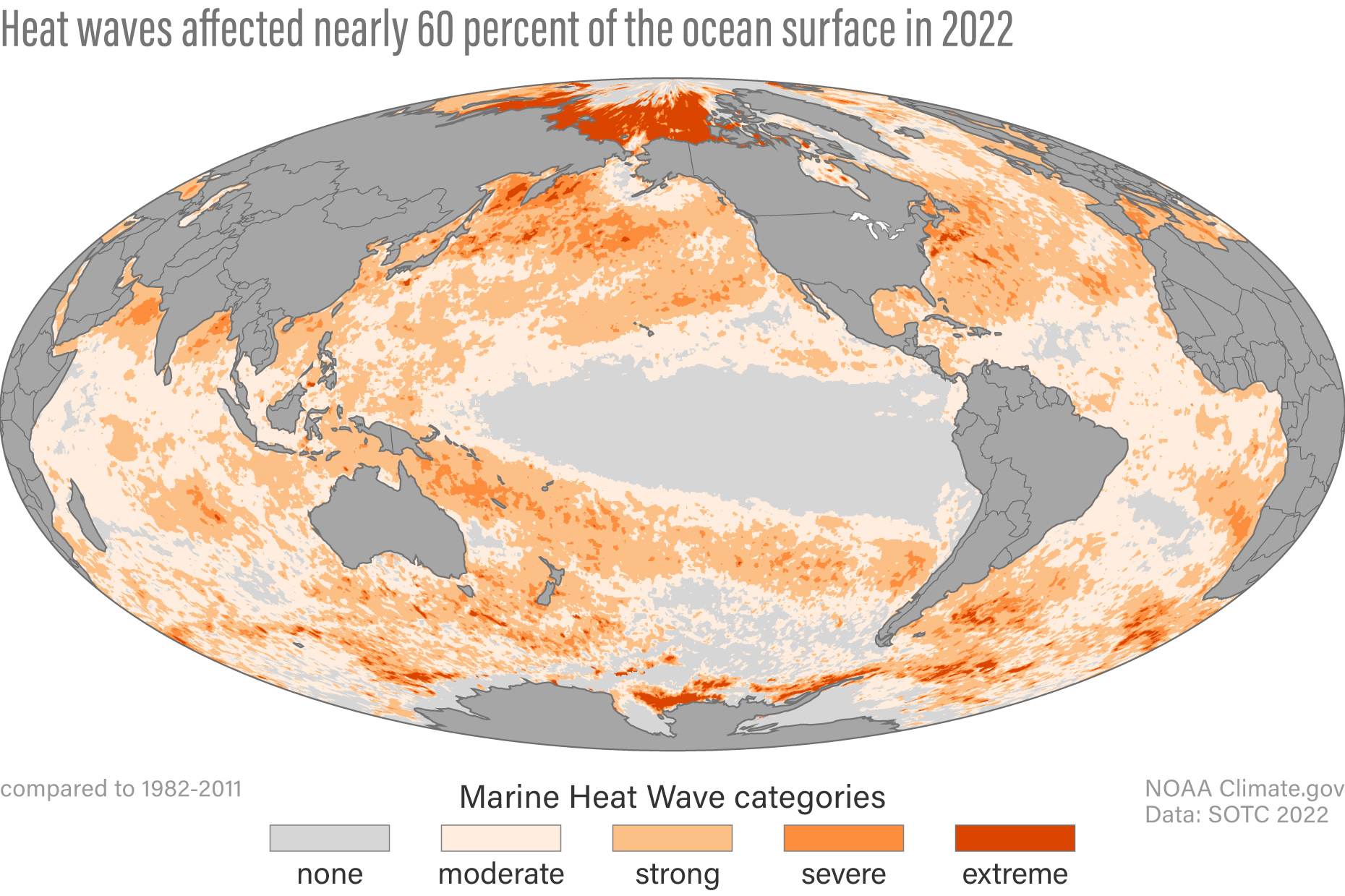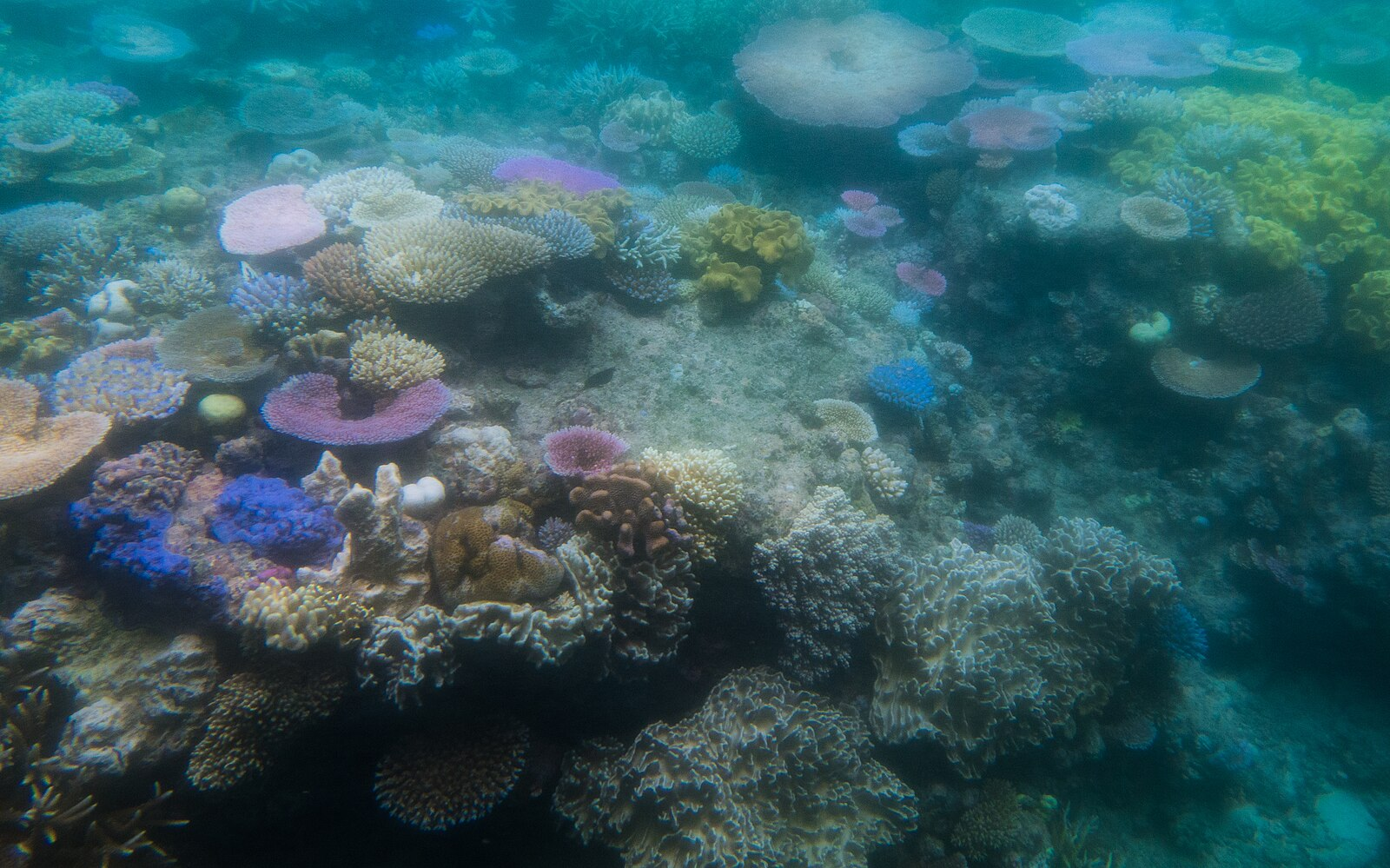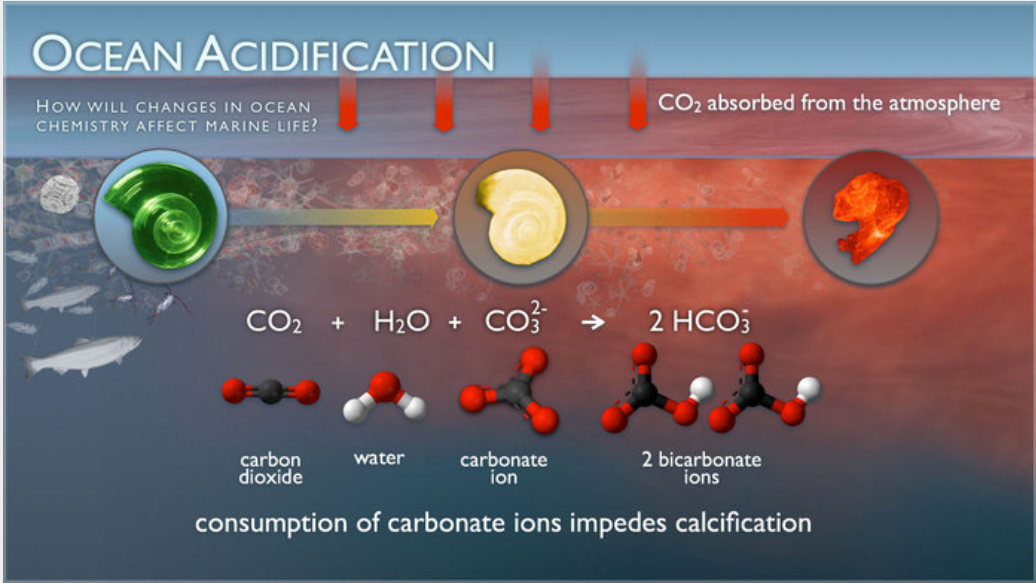IB Syllabus focus:
‘Warming, acidification and extremes stress aquatic ecosystems and can trigger population declines (e.g., coral bleaching on the Great Barrier Reef).’
Climate change and ocean acidification are intensifying pressures on aquatic ecosystems, disrupting food webs and threatening biodiversity. Their impacts extend across freshwater and marine environments, altering ecosystem stability.
Climate Change and Aquatic Ecosystems
Rising Temperatures
Global warming directly affects aquatic ecosystems. Increasing air and water temperatures can:
Reduce dissolved oxygen, stressing fish and invertebrates.
Accelerate metabolic rates, increasing food demand while reducing resource availability.
Shift species distributions towards cooler waters or higher latitudes.

Global map showing the highest marine heatwave category recorded in 2022, illustrating the widespread thermal extremes that stress marine ecosystems and reduce resilience. Category colours depict intensity; this adds concise classification detail beyond the syllabus for context. Source.
Coral bleaching: The loss of symbiotic algae (zooxanthellae) from coral tissues due to heat stress, leaving corals pale and vulnerable to mortality.
The Great Barrier Reef is a prominent example where elevated sea surface temperatures have caused widespread coral bleaching events.

Underwater photograph of bleached branching corals on the Great Barrier Reef, showing the whitening that accompanies loss of zooxanthellae during heat stress. This image links warming to coral physiological stress and population decline noted in the syllabus. No extraneous content beyond the phenomenon depicted. Source.
Melting Ice and Altered Habitats
Loss of polar and alpine ice reduces critical habitats:
Species dependent on ice (e.g., polar bears, penguins, krill) face population stress.
Meltwater alters salinity and nutrient flows, influencing marine productivity.
Freshwater ecosystems experience seasonal flooding shifts, impacting spawning cycles.
Ocean Acidification
The Chemistry of Acidification
Ocean acidification occurs when carbon dioxide dissolves in seawater, forming carbonic acid, which lowers pH. This process reduces the availability of carbonate ions required for shell and skeleton formation.

Diagram showing CO₂ dissolving in seawater to form carbonic acid, increasing hydrogen ions and converting carbonate to bicarbonate, which impedes calcification in corals, molluscs and plankton. The arrows highlight transfers and transformations referenced in the syllabus. Includes molecular detail beyond the syllabus to clarify the mechanism. Source.
Ocean acidification: The ongoing decrease in ocean pH due to absorption of atmospheric CO₂, affecting calcifying organisms such as corals, molluscs and some plankton.
Impacts on Organisms
Key groups affected include:
Corals, which require carbonate ions for reef building.
Molluscs (e.g., oysters, clams), whose shells weaken in acidic waters.
Plankton, such as coccolithophores, vital for food webs and carbon cycling.
Declines in these organisms disrupt trophic levels, threatening higher consumers including fish and marine mammals.
Extreme Weather Events
Increased Frequency and Intensity
Climate change amplifies extreme events that affect water systems:
Hurricanes and cyclones damage reefs, estuaries and coastal ecosystems.
Floods increase sedimentation and nutrient input, accelerating eutrophication.
Droughts reduce freshwater availability, concentrating pollutants and stressing aquatic life.
Synergistic Stressors
The combined effects of warming, acidification and extreme events produce synergistic impacts:
Coral reefs already stressed by heat bleaching are less resilient to storm damage.
Acidified waters reduce recovery capacity after disturbance.
Freshwater fish face compounded threats of low oxygen, altered flow regimes and pollutant concentration.
Consequences for Populations and Ecosystems
Biodiversity Loss
Populations of sensitive species decline when physiological tolerances are exceeded.
Local extinctions alter ecosystem structure, reducing resilience.
Invasive species may thrive in disturbed habitats, outcompeting natives.
Disrupted Food Webs
Collapse of primary producers, such as phytoplankton, undermines food supply.
Fisheries dependent on coral reefs and shellfish beds face reduced yields.
Migratory species encounter mismatched seasonal cues, disrupting reproduction.
Human and Societal Implications
Fisheries and Food Security
Over a billion people rely on aquatic food sources for protein.
Climate-driven collapses of fisheries threaten livelihoods and nutrition, particularly in coastal and island nations.
Economic Costs
Coral reefs support tourism industries; bleaching leads to revenue losses.
Aquaculture systems struggle with rising temperatures and acidifying waters.
Infrastructure damage from storms and flooding adds further strain on economies.
Adaptation and Mitigation
Conservation and Management Strategies
Efforts to reduce vulnerability include:
Establishing marine protected areas (MPAs) to safeguard breeding and nursery grounds.
Restoring habitats like mangroves and seagrasses that buffer storm impacts and absorb CO₂.
Enhancing monitoring of water quality and ecosystem health.
Global Action
Reducing greenhouse gas emissions is critical to limit further warming and acidification. International agreements, such as the Paris Agreement, target temperature stabilisation to protect ecosystems.
FAQ
Early life stages such as larvae and juveniles are particularly vulnerable because their shells and skeletons are less developed. Acidified waters slow shell formation, increase mortality rates, and reduce the ability of young organisms to survive to adulthood.
Phytoplankton absorb carbon dioxide during photosynthesis, which can temporarily buffer pH in local waters. However, shifts in phytoplankton species composition under stress can reduce overall carbon uptake and alter food webs, potentially amplifying ecosystem vulnerability.
Corals depend on a delicate balance between symbiotic algae and skeletal growth.
Warming disrupts this relationship, causing bleaching.
Acidification reduces the raw materials for skeleton building.
Together, these stressors create conditions where reefs cannot repair damage quickly, leading to long-term decline.
Storms and floods can increase sedimentation, smothering corals and seagrasses. Acidified conditions then slow their recovery by weakening growth and repair. Droughts intensify pollutant concentrations, adding another stressor to already compromised ecosystems.
Fisheries collapse reduces local food security.
Loss of reef structures exposes coastlines to erosion and storm damage.
Tourism industries reliant on healthy reefs suffer revenue decline, undermining livelihoods in coastal communities.
Practice Questions
Question 1 (2 marks)
Explain what is meant by ocean acidification and state one impact it can have on marine organisms.
Mark scheme:
1 mark for correct definition: e.g. absorption of CO₂ by seawater lowers pH through formation of carbonic acid.
1 mark for one accurate impact: e.g. reduces carbonate ion availability, weakens shells/skeletons of corals or molluscs.
Question 2 (5 marks)
Discuss how climate change and ocean acidification together can affect coral reef ecosystems, using the Great Barrier Reef as an example.
Mark scheme:
1 mark for identifying climate change impact: e.g. warming leads to coral bleaching from loss of zooxanthellae.
1 mark for identifying acidification impact: e.g. reduced calcification limits coral growth.
1 mark for linking combined stressors: e.g. reduced resilience makes reefs less able to recover from storm damage.
1 mark for consequences to biodiversity: e.g. decline in reef-dependent species, disruption of food webs.
1 mark for specific named example: e.g. Great Barrier Reef coral bleaching events linked to elevated sea surface temperatures.

